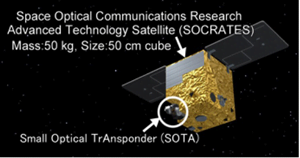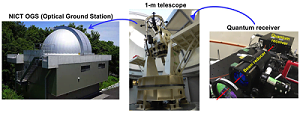TOKYO, July 13, 2017 — In a quantum-limited communication experiment between a microsatellite, called SOCRATES, in low Earth orbit and an optical ground station (OGS), researchers were able to detect a communication signal from a small, lightweight quantum-communication transmitter onboard the satellite. The transmitter, named SOTA, transmitted a laser signal to the ground at a rate of ten million bits per second from an altitude of 600 km (approximately 370 miles) at a speed of 7 km/s (approximately 2237 miles per hour).

Image of SOTA onboard SOCRATES. Courtesy of NICT.
Information from the satellite was received in a single-photon regime at an OGS in Koganei City, Japan. The signals were received at the OGS by a 1-m telescope, which was used to collect the transmitted photons and guide them to the quantum receiver. The information was decoded using a Quantum Key Distribution (QKD) protocol.
This research, performed at the National Institute of Information and Communications Technology (NICT), has demonstrated that satellite quantum communication could be implemented with small, low-cost satellites. SOCRATES is a 50 kg satellite. The transmitter SOTA weighs 6 kg.
Because of the divergence of the laser beam and the limited aperture of the telescope to gather the photons, the signals transmitted from SOTA suffered from big losses, and most of the transmitted photons were lost before reaching the receiver. Additionally, many photons were scattered and absorbed in the atmosphere. As a result, the signal arriving at the OGS was extremely weak, carrying an average of less than 0.1 photons per pulse.

Images of the NICT Optical Ground Station, the 1-m telescope and the quantum receiver. Courtesy of NICT.
Since such weak signals cannot be detected by using conventional photodetectors, the quantum receiver used photon counters — extremely sensitive detectors that can detect single photons. This enabled a much more efficient communication than conventional satellite optical communication. Also, by using signals with less than one photon per pulse, quantum cryptography would allow the presence of an eavesdropper to be detected.
The quantum states were discriminated by a receiver with four photon counters, with a quantum bit error rate below five percent, demonstrating the applicability of the technology to satellite-to-ground laser communication and QKD.
The research, which demonstrated that long-distance communication could be possible with very low electric power, could open up a path to deep-space optical communication with exploration spacecraft.
The researchers plan to increase the transmission speed and improve the precision of the tracking technology. The ultimate goal is to maximize the secure key delivery from space to ground by using quantum cryptography. This, in turn, would enable a secure global communication network that could withstand future potential threats to security from quantum computers, as technology for quantum computers progresses.
The research was published in Nature Photonics (doi:10.1038/nphoton.2017.107).
Additional information is available at the NICT web site.